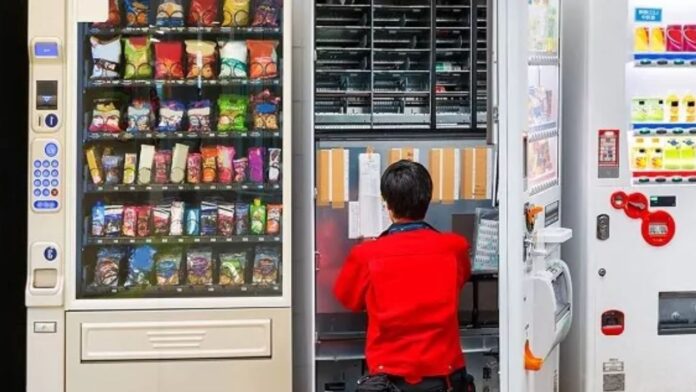Vending machines, those trusty providers of snacks, drinks, and even electronics, have revolutionized how we access goods on the go. Yet, beyond their convenience lies a question often overlooked: How much does a vending machine weight? Understanding the weight of vending machines is more than just a matter of curiosity; it’s a practical consideration for installation, transportation, and maintenance.
From compact snack dispensers to large-scale beverage behemoths, the weight of vending machines varies significantly based on factors like size, materials, and features. In this article, we’ll delve into the intricacies of vending machine weight, exploring its impact on everything from placement locations to regulatory compliance. So, buckle up as we uncover the surprising weight behind those beloved vending companions.
Affecting Vending Machine Weight
How much does a vending machine weight Factors affecting vending machine weight include the type and quantity of items, ranging from lightweight snacks to hefty beverages. The material composition of the vending machine itself also contributes, with steel-bodied machines being heavier than those made from lighter materials.
Frequent restocking intervals increase weight due to added products, while vandalism or theft may reduce it if items are removed forcefully. Maintenance and repairs may involve adding or removing components, impacting weight. Temperature and humidity are two environmental variables that impact a product’s weight, influencing the overall load. Transporting the machine or relocating it also affects its measured weight.

Standard Weight Range for Vending Machines
The standard weight range for vending machines varies depending on size, design, and purpose. Typically, smaller snack vending machines may weigh around 300 to 600 pounds, while larger models accommodating beverages can weigh between 500 and 900 pounds.
Specialized machines like those for ice cream or frozen foods might exceed 1000 pounds due to added refrigeration units. Factors influencing weight include construction materials like steel or aluminum and features like coin mechanisms and bill validators. Transporting and installation also require consideration, as weight affects maneuverability and placement logistics, with heavier machines necessitating specialized equipment for handling.
Vending Machine Weight Classifications
Vending machine weight classifications categorize machines based on size, capacity, and intended use. Light-duty models, typically for snacks or small items, weigh between 300 and 600 pounds. Standard-duty machines, accommodating beverages and larger snacks, range from 500 to 900 pounds. Heavy-duty vending machines, often for bulkier items or specialized products like ice cream, can exceed 1,000 pounds.
These classifications consider factors such as construction materials, structural integrity, and the inclusion of refrigeration units. Understanding weight classifications aids in selecting appropriate machines for specific locations and applications, ensuring efficient operation and reliable performance in diverse vending environments.
Weight Distribution in Vending Machines
Typical weight distribution in vending machines is strategically engineered to ensure stability and functionality. Most weight is concentrated at the base to provide a sturdy foundation, preventing tipping or instability during operation. Internal components, such as the product delivery mechanism and refrigeration units (if applicable), contribute to the overall weight distribution.
Additionally, heavier items are often placed lower within the machine to maintain balance and ease product retrieval. Careful consideration of weight distribution ensures that vending machines remain secure and operational, minimizing the risk of damage or malfunction while maximizing user convenience.
Materials Impacting Vending Machine Weight
Materials impacting vending machine weight vary depending on construction and design. Steel-bodied machines tend to be heavier due to the density of the material, providing durability and security. Aluminum constructions offer lighter alternatives without compromising strength, suitable for portable or outdoor vending setups.
Additionally, the type of insulation used for refrigerated vending machines influences weight, with thicker insulation contributing to heavier units but better temperature control. Plastic components, while lighter, are often used for non-structural parts to reduce overall weight. Careful selection of materials balances durability, portability, and functionality, ensuring vending machines meet diverse operational needs while managing weight efficiently.
Weight Variations Among Different Vending Machine Types
Weight variations among vending machine types depend on their intended purpose and features. Snack vending machines typically weigh between 300 to 600 pounds, while beverage vending machines can range from 500 to 900 pounds due to their larger size and capacity. Specialized machines like those for ice cream or frozen foods may exceed 1000 pounds due to added refrigeration units.
Variations also arise from construction materials, with steel-bodied machines heavier than those made from lighter materials like aluminum or plastic. Understanding these weight differences helps select the appropriate vending machine type for specific locations and operational requirements.
The Weight of Snack Vending Machines
Generally speaking, snack vending machines weigh between 300 and 600 pounds. These devices dispense several packaged snacks, such as chips, candies, and pastries. Internal components, construction materials, and machine size determine snack vending machine weight. While smaller models may be lighter and more portable, larger machines with higher capacities tend to be heavier.
Steel-bodied machines offer durability and security but contribute to increased weight, while lighter materials like aluminum or plastic reduce overall weight without compromising functionality. Understanding the weight of snack vending machines is crucial for installation, transportation, and operational considerations.
Weight Considerations for Beverage Vending Machines
Beverage vending machines typically weigh between 500 and 900 pounds, reflecting their larger size and capacity than snack machines. These units are designed to dispense various beverages, including sodas, water, juices, and energy drinks. Weight considerations for beverage vending machines encompass construction materials, internal components, and refrigeration systems for maintaining product freshness.
Steel-bodied machines provide durability but contribute to increased weight, while lighter materials like aluminum offer a balance between strength and portability. Understanding these weight considerations is essential for installation, transportation, and ensuring stability and functionality in diverse vending locations.

Factors Influencing Combo Vending Machine Weight
Combo vending machines, integrating both snack and beverage functionalities, weigh between 600 to 1000 pounds on average. The weight of combo vending machines is influenced by various factors, including their size, capacity, and construction materials. These units must accommodate a wider range of products, necessitating sturdy construction to support snacks and beverages.
Steel-bodied machines provide durability but contribute to increased weight, while lighter materials like aluminum or reinforced plastics offer alternatives. Additionally, including refrigeration units for beverages and the arrangement of internal components impact overall weight. Understanding these factors helps select and manage combo vending machines for optimal performance and convenience.
Installation Challenges Related to Vending Machine Weight
Installation challenges related to vending machine weight encompass logistical considerations and safety precautions. Heavier vending machines require specialized equipment and a workforce for transportation and positioning, especially when navigating tight spaces or stairs. Ensuring proper weight distribution during installation prevents structural damage and minimizes the risk of tipping.
Additionally, floor reinforcement may be necessary to support the weight of vending machines, particularly in elevated or high-traffic areas. Accessibility for maintenance and restocking must also be considered when determining installation locations. Addressing these challenges requires careful planning and coordination to ensure vending machines’ successful and secure installation in various environments.
Transportation and Handling Concerns for Heavy Vending Machines
Transportation and handling concerns for heavy vending machines revolve around logistical challenges and safety precautions. Specialized equipment, such as pallet jacks or forklifts, is often required to load and unload these machines onto delivery trucks and position them at their intended locations.
When properly secured and cushioned during shipment, the machine, and surrounding items are less likely to sustain damage. Additionally, trained personnel are essential to safely maneuver heavy vending machines through narrow passages or up and down stairs. Prior planning, including route assessment and coordination with building managers, ensures smooth transportation and minimizes disruptions. Adhering to safety protocols is paramount to preventing accidents and ensuring successful deployment.
Vending Machine Weight on Placement Options
The impact of vending machine weight on placement options is significant, dictating suitability for various environments. Heavier machines require sturdy flooring and may be limited to ground-level placements due to weight-bearing capacity considerations. Elevators and narrow doorways may pose challenges for transportation, restricting placement options in certain buildings.
Outdoor installations necessitate stable surfaces to support the weight and withstand environmental factors like wind and rain. Understanding the weight of vending machines informs decisions on placement locations, ensuring compatibility with structural constraints and accessibility requirements. Careful weight consideration enables optimal positioning to maximize visibility, convenience, and operational efficiency.
Weight Capacity versus Machine Weight
Finding the balance between weight capacity and machine weight is crucial for efficient vending operations. While vending machines must have sufficient weight capacity to accommodate stocked items, they should not exceed structural limitations or pose transportation challenges. Striking this balance ensures stability during operation and prevents damage to floors or surrounding infrastructure.
Regular assessments of weight capacity help prevent overloading, which can lead to malfunctions or accidents. Optimizing machine weight through thoughtful design and material selection enhances portability and installation flexibility, facilitating placement in diverse environments. Achieving equilibrium between weight capacity and machine weight promotes reliable performance and customer satisfaction.

Weight Maintenance Tips for Vending Machine Owners
Vending machine owners can maintain optimal performance by implementing weight maintenance strategies. Regularly inspecting machines to ensure they are not overloaded helps prevent strain on internal components and reduces the risk of malfunctions. Monitoring product inventory and adjusting stocking levels accordingly prevents excess weight buildup.
Cleaning and removing debris from vending machine interiors prevents unnecessary weight accumulation and maintains hygiene standards. Properly distributing weight within the machine promotes stability and prevents tipping hazards. Additionally, scheduling routine maintenance checks with qualified technicians ensures that weight-related issues are promptly addressed. Implementing these weight maintenance tips prolongs the lifespan of vending machines and enhances overall operational efficiency.
Regulations and Guidelines Concerning
Weight restrictions on vending machines vary by jurisdiction and are sometimes influenced by requirements for accessibility and safety. These regulations may dictate maximum weight limits for different vending machines to prevent structural damage or hazards during transportation and installation. Additionally, guidelines may include recommendations for proper weight distribution within the machine to ensure stability and prevent tipping.
Compliance with these regulations ensures that vending machines meet safety requirements and can be safely operated and maintained. Vending machine owners and operators should stay informed about relevant regulations and adhere to industry best practices to mitigate risks and ensure regulatory compliance.
Future Trends in Vending Machine Weight Management
Future trends in vending machine weight management focus on innovation and sustainability. Advancements in materials science lead to the development of lightweight yet durable materials, reducing the overall weight of vending machines without compromising structural integrity. Modular designs allow for easy disassembly and transportation, facilitating installation in diverse locations.
Integration of smart technologies enables real-time monitoring of product inventory and machine weight, optimizing restocking processes and preventing overloading. Furthermore, there’s a growing emphasis on eco-friendly designs, with vending machines incorporating recycled materials and energy-efficient components to minimize environmental impact. These trends reflect a shift towards more efficient, versatile, and environmentally conscious vending solutions.
Conclusion
The weight of a vending machine varies depending on factors such as its type, size, and construction materials. Snack vending machines typically weigh between 300 to 600 pounds. In comparison, beverage vending machines can range from 500 to 900 pounds. Factors influencing weight include the inclusion of refrigeration units, product capacity, and structural integrity. Understanding the weight of vending machines is essential for transportation, installation, and operational considerations. As technology and materials evolve, future vending machine weight management trends will likely focus on innovation, sustainability, and efficiency, reflecting a dynamic and evolving industry landscape.
FAQ
How much does a vending machine weigh?
The weight of a vending machine varies depending on its type and size. Snack vending machines typically weigh between 300 to 600 pounds, while beverage vending machines can range from 500 to 900 pounds. Specialized machines, such as those for ice cream or frozen foods, may exceed 1000 pounds due to added refrigeration units.
Why do vending machines weigh differently?
Vending machines weigh differently based on construction materials, product capacity, and additional features like refrigeration units. Steel-bodied machines are heavier but offer durability, while lighter materials like aluminum reduce weight without compromising strength.
Can vending machines be transported easily?
Due to their weight, transporting vending machines requires specialized equipment and manpower. Smaller models may be more manageable, but larger machines often require pallet jacks or forklifts.
Are there weight restrictions for vending machine placement?
Weight restrictions may apply depending on the location and structural capacity. Vending machine owners should ensure that placement areas can support the machine’s weight to prevent damage or accidents.
How can I determine the weight capacity of a vending machine?
The manufacturer typically specifies the weight capacity of a vending machine in its specifications. Adhere to these capacity limits to avoid overloading the machine.

